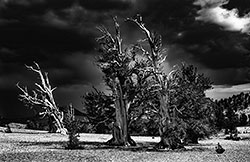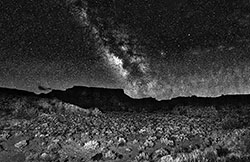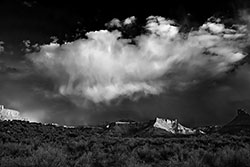 |
| Photo 1 - This image of bristlecone pines in the high country of California was made by converting a color file to black-and-white, creating a luminous effect. |
In the first century of photography, it was a medium without color. Yes, sometimes sepia tones were added in the darkroom, or prints were hand painted to add color. In general, though, black-and-white (b&w) was the rule.
Today we live in a world of sometimes lurid color. We see it everywhere, in all media. And yet, there is still a place for monotone images. The choice of b&w can create mood, bring out details sometimes lost in color, and make images that are lovely to look at.
When Steven Spielberg was filming the movie Schindler’s List, he chose to make it (mostly) in black-and-white to create the dark mood of the Holocaust. It won many Academy Awards, including best picture, best director, and best cinematography.
Although he did some work in color, landscape photographer Ansel Adams is known almost exclusively for his black-and-white images. Even today b&w prints have an important place in the fine art world.
 |
| Photo 2 -
A picture of the Milky Way over a silhouetted butte in Professor Valley was made into a black-and-white image, making the many stars of the night sky stand out. |
Modern digital cameras claim to capture literally millions of colors, and yet through the use of post processing apps these files can be converted very effectively to black-and-white. When Adams and others made prints in the darkroom, they used many techniques to achieve their ends. These included selectively blocking or “burning” some areas of the image during exposure in the enlarger, even using bleaches to brighten areas and bring out details.
Today we can do more, because when an image file is converted to monotone, the color information remains and can be called upon to selectively process the final result. The photographer can brighten or darken monotone areas based on their underlying colors. Thus, we can create b&w photographs with a special look even darkroom magicians such as Adams could not attain.
The examples here were made using the process just described. The first is a picture of ancient bristlecone pines in California. The original photograph was made on color film using a 4x5 inch view camera, then the transparency was drum scanned to create a digital file. I used Photoshop and one or two other editing apps to create a luminous look. A print of this image made on a metallic-toned paper is currently hanging in Printworks Gallery, 1105 S. Hwy 191 in Moab.
 |
| Photo 3 -
This picture of a storm cloud over the La Sal Mountains was digitally converted to monotone. Selective controls in Photoshop were used to illuminate the red rocks. |
The second example is based on a digital picture I made in Professor Valley, looking south toward the Milky Way from near Fisher Towers. I used a special flashlight during the long exposure to fill in some of the foreground. The picture is not especially notable in color, but processing it as b&w makes the multitudinous stars stand out clearly against the black sky.
A third example was also made in Professor Valley, looking toward the Castle Valley buttes and a clearing thunderhead over the La Sal Mountains at sunset. I was able to manipulate the underlying tones of the red rock buttes to make them stand out and create a pleasing b&w image.
David L. Brown is a partner in Moab Printworks and Printworks Gallery where his fine art photography can be seen. He has led photo tours and workshops here since 2015. He can be reached at 435-210-8158 and be sure to mention you read about it in Moab Happenings.
_____________________________________________
David L. Brown is a landscape photographer who has led photo tours from his base in Moab since 2015, now as Printworks Photo Tours. His fine art prints can be seen at Printworks Gallery, 1105 S. Hwy. 191. He invites you to visit or call at 435-355-0121.
|